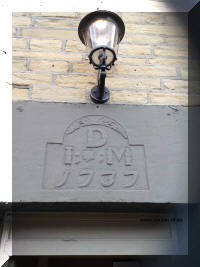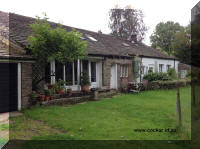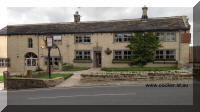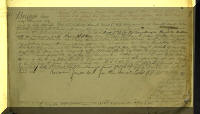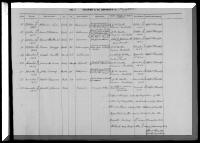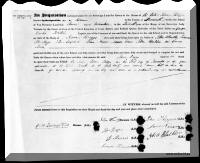Sarah Elizabeth Briggs (1828-1874)
Sarah Elizabeth Briggs, daughter of Isaac Briggs and Alice Dean, was born on 28 Jul 1828 in Norland, Halifax, Yorkshire, England and christened on 15 Nov 1831, She married John Cocker, son of John Cocker and Margaret Norman, on 22 Aug 1845 in Green Ponds, now Kempton, Tasmania and died on 30 Aug 1874 in Barrington, Tasmania at age 46.
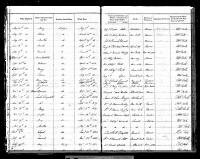

DATING back to settlement by the Danish Vikings from 650, Barkisland is a village in West Yorkshire, 1.6 km east of Ripponden and 6.4 km south-west of Halifax, in the UK. Ripponden is a village which was once a main stopping place for the Halifax to Liverpool stagecoach. In 1811 nine cotton mills were in operation in the Ripponden area deriving power from the river Ryburn making it a thriving commercial centre. Elland is a larger market town in Calderdale by the River Calder, some 6 km from Barkisland.
In 1620 the DEAN family built Old House Farm in Barkisland. The building incorporated part of an older building by Simeon Sharrock whose initials are shown on the datestone below. In 1736 the owner John Dean died, and left the farm to his eldest son John, and the land on the other side of the road to his youngest son Joseph. In 1737 Joseph and his wife Mary built New House Farm.
In 1785 Joseph’s son Moses leased the farm land, and because it was not viable as a farm, he opened New House Farm as a pub named ‘Sign of the Cross’ after a nearby stone Celtic Cross. In 1798 Moses died, aged 49 years. He left his property to be divided among his six children, Joseph, Sarah, John, Thomas, George Stansfield and Alice once they were 21 years old. This decision by Moses, to share his estate equally was the start of a series of disasters.
On 23 January 1803 in St Mary the Virgin Church of England at Elland, Moses’ widowed wife Mary (née STANSFIELD, married a local stonemason, John AINLEY. John tried to comply with the terms of the will and some of the children were paid. The eldest son, Joseph, became a school teacher in Liverpool and he put pressure on John Ainley but there was not enough money to pay everyone. When the youngest daughter Alice, who was born in 1797, came of age there was nothing left and the pub had been mortgaged three times over, which eventually led to a fraud trial. John Ainley moved to a cottage opposite the pub and was cleared by the court because he gained nothing out of the will. However, on 27 December 1825 John Ainley, Innkeeper of Barkisland, was declared bankrupt. The Leeds Intelligencer reported on Thursday 5 Jan 1826
In Ainley’s bankruptcy:
Whereas a commission of Bankrupt is awarded against JOHN
AINLEY of Barkisland, in the Parish of Halifax and County of York,
Innkeeper and Victualler Dealer and Chapman and he being declared
bankrupt is hereby required to surrender himself to the
Commissioners in the said Commission named, or the major part of
them on the fourth day of January next at six o'clock in the
evening and on the fifth day of January next at ten o’clock …..
make a full discovery and disclosure of his estate and affects:
when and where the creditors are to come prepared to prove their
debts and at the Second Sitting to choose Assignees and at the
last sitting, the said bankrupt is required to finish his
examinations. All persons indebted to the said bankrupt or that
have any of his effects are not pay or deliver the same but to
whom the Commissioners shall appoint, but give notice to Mr.
Edmund Walker, solicitor, No. 29 Lincoln’s Inn Fields, London or
to Messrs. L. and N. Alexander, Solicitors in Halifax
L. and
N. Alexander
The Leeds Mercury reported on a an insolvent debtors hearing at Wakefield Court House nearly five years later on Saturday 26 Sep 1840 for John Ainley, late of Ripponden Bank, in the West Riding of Yorkshire, innkeeper and formerly building contractor and innkeeper.
Alice had married Isaac Briggs in 1821 and on 22 May 1827 Isaac was also declared bankrupt. The pub, Sign of the Cross, was sold along with the other land and assets by public auction on 29 June 1827. The pub still trades today as one of the only two in Barkisland, and is now known as the ‘Fleece Inn’.

Isaac Briggs, the second born child of Grace (née FIRTH) and Joseph Briggs was born in Elland and christened on 25 October 1789. Joseph (born in 1747 in Barkisland and died in 1829 at Ripponden) and Grace had married in Elland on 15 February 1779. Other children born to Joseph and Grace were John, Elizabeth, Isaac, Hannah, Susan and Benjamin.
Isaac Briggs and Alice Dean’s marriage was on 27 October 1821 in
St John the Baptist Church, Halifax, when Isaac was recorded as a
manufacturer; he was in fact a weaver. They had three
children: Mary, Alice and Sarah Elizabeth. However when Isaac was
declared bankrupt in 1827 his occupation was recorded as dealer
and chapman. A chapman was an itinerant dealer or hawker.
At that time insolvent debtors and bankrupts were different at law
and bankruptcy was restricted to traders making their living by
buying and selling. Many insolvent debtors described themselves
fictitiously as 'dealers or chapmans’ to qualify for bankruptcy,
which was only extended to include most skilled craftsmen after
1861.
Isaac, was able to read and write and was a weaver, like his father. It appears the first two children, Mary and Alice died young and Isaac must have been desperate to provide for his wife who was pregnant with Sarah Elizabeth. Desperate, he resorted to crime and became a member of an infamous local gang of forgers. The Lancaster Gazette (and other local papers) reported widely on the trial and on 24 May 1828 heralded the committal for trial of six men. It is reproduced here:
Just days before Sarah Elizabeth was born Isaac entered a guilty plea to two charges and on 19 July 1828 he was sentenced to death at the City of York Summer Assizes on both accounts. Reprieved, Isaac was sentenced to transportation for life. He spent eight months on the hulk Retribution anchored at Woolwich in the Thames River prior to his transportation to Van Diemen’s Land (VDL) and was incarcerated at York Gaol prior to this. This was reported in the Yorkshire Gazette on Saturday 20 Sep 1825:

Isaac departed London for Hobart Town on 26 March 1829 aboard the convict ship Lady Harewood which was built at Thames, England in 1791. There were 208 convicts aboard with only one death during the 124 day journey which ended at Hobart Town on 28 July 1829, the day Isaac’s daughter Sarah Elizabeth turned one. At 40 years of age Isaac was 5 feet 4¼ inches [164 cm] tall, brown whiskers, an oval visage with a perpendicular forehead, dark brown eye brows and dark hazel eyes. He had a long nose and medium to thick lips with a medium long chin. His trade was given as wool carder.
Upon completion of the convict arrival process in Hobart Town, Isaac was sent to the male house of correction, the Campbell Street penitentiary. From there he was sent to the Female House of Correction- the Female Factory, at the Cascades in South Hobart. There, he taught the convict women how to sort/comb/card and spin the wool. Wool prepared by the female prisoners at the Cascades Female Factory was sent to Maria Island to be woven into cloth. Having had experience as a wool carder/comber/sorter he was presumably regarded as an expert in this field. And Maria Island is where Isaac was soon sent. He arrived there in November 1829 (occupation given as weaver) where Commander Major Daunt Lord had a factory which produced 100 yards (91 metres) of cloth per week.
It is likely he was on the maiden voyage of the VDL government
cutter Charlotte which departed with prisoners and stores for
Maria Island on 26 October 1829.
On 7 March 1832 he was
recommended for assignment but instead he was one of twenty-four
male convicts detained to assist in the closing down of the first
Maria Island settlement. Isaac was still on Maria Island in April
1832 and may have left in September with the last of the convicts
and Major Daunt Lord and his family.
Isaac was ‘assigned’ to Port Arthur in 1832 and in 1833 was on ‘public works’—location not specified. From 1840–1845 he was at Bridgewater—when not on the tread-wheel in Hobart or in the local lock-up. Isaac’s records show he spent many days on the dreaded tread wheel in gaol—for 21 days from 13 August 1839 which was only nine days before his wife Alice and daughter Sarah Elizabeth were to have arrived in Hobart.
The years from 1832 were clearly unkind to him as he was regularly punished for being drunk. In May 1840 the Lieutenant-Governor deprived him of his Ticket of Leave and ordered him to three months hard labour on the roads at Green Ponds.
Meanwhile, in September 1838 Alice Briggs and her remaining living daughter, Sarah, had departed Liverpool, England for Sydney to join her husband Isaac in VDL. Isaac’s brother Benjamin with his wife Lydey and their four children; Joseph, Elizabeth, Sarah, Maryanne and Lydia accompanied them, with Lydia their fifth child probably born at sea on the James Moran journey to Sydney.
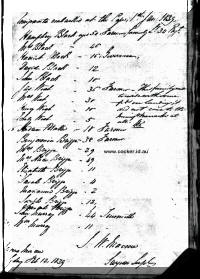
Their ship Dunlop, with Captain Bance in command of eighty-one emigrants from the UK headed for Hobart Town, ran ashore in fine weather at Cape Town, Cape of Good Hope, South Africa on 24 November 1838, going to pieces within hours. The Briggs families walked into Cape Town where for almost 6 weeks, they were at the mercy of local benevolent societies; a public subscription for donations having been established.
On 1 January 1839 they departed Cape Town on the James Moran, arriving in Port Jackson, NSW on 11 February 1839.
Five months later, on 17 July 1839, Alice and Sarah Briggs left Sydney aboard the Medway at the expense of the VDL government. The journey from Sydney to Hobart Town took an extraordinary five weeks. There were extremely bad storms and Master Borthwick WIGHT had to take measures to protect the passengers, one being Lady Jane Franklin, wife of Lieutenant-Governor John Franklin.
Eleven months after leaving Liverpool and within days of her destination, Alice died. She was buried at sea on 1 August 1839 off the Bay of Fires, north-east VDL. This event and her interactions with Sarah Briggs are recorded in Lady Jane Franklin’s journals.
Thursday 1st August
Snachall told me when bringing my
breakfast, that the poor daft woman Mrs Briggs had died about an
hour before - It was only at dinner yesterday that I heard she was
seriously ill, though some jokes had been afloat for a day or two
previously as to Mr. Grant giving her Mollison's pills, sometimes
whole, sometimes pounded, sometimes in a powder by way of variety
- I thought I would go and see her either after dinner or next
morning, but left it till morning - her complaint appears to have
been inflammation of the bowels and she said all thru' her
indisposition that she should die. At 12 o'clock I heard the
bell toll, and took it to be a mark of decent respect to her
memory, but presently Mr. Elliot knocked at my door and asked if I
would be present at the funeral. I made what haste I could to go
on deck, where Captain and sailors and the women assembled and Mr.
Braim read the service which he did very well.
Mrs Briggs had a
little girl on board, 11 or 12 years old, she was said to have
behaved very ill to her mother and to have shown not the least
feeling at her death - the child was present, was observed to
watch very attentively and to be affected at the disappearance of
her mother in the waves - I sent for the child after dinner in my
cabin and found her very interesting and as I thought clever,
expressing herself in terms and in a manner beyond her years.
She did not express any sorrow at her mother's death, but could
have wished she had been buried on the land, she said. I mentioned
at tea the favourable impression she had produced on me and then
found that all the gentlemen partly Wright, Grant, Braim and
Elliot agreed in thinking her a very bad child and Captain who
was never mistaken - he said in anyone's countenance thought she
had one of the worst he had ever met.
Tuesday 6th/3 weeks
-had sick headache - At night the wind fell and we rolled more in the calm than before - having heard that Sarah had put on her other frock and the pinafore she had made herself and was very anxious to know if I should send for her (which was owing no doubt to Mr. Braim and M. Stanley having talked to her, I sent for her while in bed. She looked very tidy, with her hair brushed back behind her ears - read to her, made her read …
They eventually arrived in Hobart Town passing Adventure Bay, Bruny
Island on 19 August. Lady Franklin arranged for Sarah to be
admitted to the Queens Orphan School at New Town and called in a
few days later.
Her journal continued on
22 August 1839:
I enquired for Sarah Briggs who arrived in the school yesterday and has been scrubbed and washed and clothed afresh, operations which Mrs Gazard assured me were highly necessary. I sent for Sarah who seemed pleased to see me, but flung herself round a little when I gave her some good advice.
Sarah stayed in the
Orphan School
for two years and three months, being discharged on 12 November
1841 when she was released to the care of her Uncle Benjamin
Briggs and his wife Lydey. Her admission and release from the
Orphan School is recorded in the
admission records:
Benjamin and family had arrived in VDL on 3 April 1840 on the Marion Watson from Sydney some eight months after Sarah. Lydey Briggs died in childbirth, aged 36, on 8 November 1842 at Brighton—Sarah probably cared for her younger cousins. Brothers Benjamin and Isaac were fellmongers (removing hair from animal hides in preparation for tanning) in the Black Brush district. Benjamin and Lydey’s son, Joseph was still carrying on this business in 1876.
Sarah, aged 17, married convict John Cocker, aged 33, at Green Ponds on 22 August 1845. John had been sentenced to 21 years’ transportation after conviction for his third attempt at desertion from the British Army; the last time in Montreal around the time of the Canadian Uprising. He received a conditional pardon in 1849 and he and Sarah had eleven children.
Benjamin Briggs died on 28 July 1846. His death
was registered at Brighton by John Cocker of Green Point. Records
show John’s mark (X) as the informant.
According to his
inquest on 2 November 1852 Isaac Briggs died at Black Brush of
natural causes. Evidence given by friends George Gibbard,
farmer Thomas Hampton (who married Isaac’s niece Elizabeth
Briggs), and by local doctor Charles Lempriere, paints a sad
picture of a lonely man who had probably become an alcoholic.
He was buried on 4 November 1852 by Reverend John Burrowes in an
unmarked grave at St Marks Church of England, Pontville.
John and Sarah's first child, John, was born at Brighton on
22 May 1846. Not long after their marriage John and Sarah chose to
leave the Brighton District.
By April 1848 when Sarah gave birth to her second child
(Sarah) they were at Lincoln in the Macquarie River district of
Campbell Town. By April
1851 the Cocker family was living at Hadspen where they remained
for about nine years and was where the next three children were
born. Between 1860 and
1863 the growing family lived at Hagley, Quamby and Westbury.
The eleventh and last child was born at Barrington in 1870.
Religion played a large part in Sarah and John’s life as all their children were baptised in the Methodist faith within months of birth. Journeys from Hadspen to Launceston’s Paterson St Church were made on four occasions, and for the youngest, Jane Evangeline, a trip was made from Barrington to Latrobe. What may be a 15-minute journey by car today was probably a full day’s return journey by horse and cart or bullock and dray and a major commitment.
John died in 1872 when accidentally killed by falling into the drum of a steam threshing machine. Within three months of his death Sarah made application for charitable assistance for her four youngest children. Sarah died from a cramped bowel on 30 August 1874, aged 46 at the home of her son John at Barrington, two years after the death of her husband.


